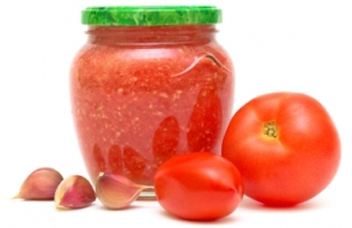Adjika with tomatoes
Products for 1.5-2 liters of adjika
Tomatoes - 2 kilograms
Bulgarian pepper - 300 grams
Chili pepper - 100 grams
Garlic - 100 grams (2-3 heads)
Horseradish - 150 grams
Salt - 3 tablespoons
Sugar - 3 tablespoons
Apple cider vinegar - 1/4 cup
Sunflower oil - 1 glass
Coriander, hops-suneli, dill seeds - to taste
How to cook adjika for the winter
Wash the tomatoes, pour over with boiling water and peel them. Cut each tomato in half, remove the stalk.
Wash the bell pepper, cut in half, remove the stem and seeds, cut each into 4 parts.
Peel the garlic, peel the hot pepper from the seeds and cut into several pieces. Horseradish to clean.
Grind all vegetables with a meat grinder or blender, put in a saucepan, add oil and cook for 1 hour over low heat without a lid.
When adjika boils down the excess liquid and reaches a sauce-like consistency, add vinegar, salt and sugar, spices. Mix the adjika well and cook for another 10 minutes.
Pour adjika into sterilized jars, roll up the lids, cool and store.
Adjika from pepper (without cooking)
ProductsHot green or red peppers - 400 grams
Garlic - half a large onion
Salt - 2 tablespoons
Cilantro - 1 small bunch
Basil - 1 small bunch
Dill - 1 small bunch
Coriander seeds, thyme, thyme - pinch each
How to make adjika
1. Wash the pepper, put in a bowl, cover with warm water and leave for 5-6 hours (you can overnight).
2. Drain the water, cut the pepper and remove the seeds.
3. Peel the garlic.
4. Wash cilantro, basil and dill under running water and dry, peel the basil from the twigs.
5. Grind pepper, garlic and herbs through a meat grinder twice.
6. Grind the coriander with a mortar, add to the chopped mixture.
7. Add salt, mix well and screw into sterilized jars or bottles.
Fusofacts about adjika
Adzhika cooking traditionsHot peppers, salt and spices are put in the classic Abkhaz adjika. That is, tomatoes and bell peppers are not added at all. The color of adjika can be not only red, but also green, if green hot pepper is taken as a basis, and fresh and dried herbs are added to it, necessarily cilantro and utskho-suneli (the Georgian name for blue fenugreek). However, in Russia, adjika is most often prepared with tomatoes due to the prevalence of this vegetable.
Today, adjika components are crushed with a blender or ground in a meat grinder, and in the old days they were ground between two flat stones.
The word "adjika" in translation from the Abkhaz language means "salt". This seasoning is typical for Georgian, Armenian and Abkhazian cuisine. Traditionally, the mountaineers dry up the pods of red hot pepper in the sun and grind them with salt, garlic and spices.
Do I need to cook adjika
Traditionally, adjika is prepared without boiling, since the acid and salt contained in the pepper are natural preservatives. However, given the different storage conditions for adjika, it is recommended to cook it for greater preservation and increase the shelf life (up to 2 years). Besides, properly cooked adjika will not ferment.
What to add to adjika
To diversify the adjika, you can add 3 medium apples and 1 medium carrot for each kilogram of tomatoes. Adjika will acquire a sweetish tint. You can also add chopped walnuts and mint.
If adjika fermented
As a rule, adjika ferments if it was not cooked, or if salt was not added during the cooking of adjika. Drain adjika into a saucepan and cook for 3 minutes after boiling.To enhance the effect of preservatives, add a tablespoon of salt for each liter of adjika. Return the boiled adjika to the jar, after washing it and drying it well. There is nothing wrong with fermentation - it will give adjika a more fermented taste and harshness.
The benefits and serving of boiled adjika
Adjika improves appetite and is good for digestion, but spicy seasoning should be consumed in small quantities so as not to irritate the gastric mucosa.
Adjika is served with fried or stewed meat, the seasoning is not cooked, it is added to ready-made dishes.
Ideally serve adjika to cabbage soup or borsch, on bread, as a sauce for pasta and meat.
About security
Gloves should be worn when handling hot peppers to avoid burns and strong odors.



